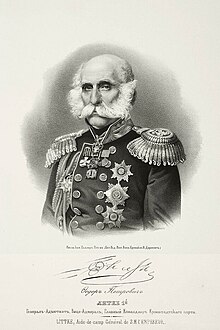Mikhail D. Levashev (Russian : Михаи́л Дми́триевич Левашо́в; spelt "Levashef" in the United States) (c. 1738–1774-76) was a Russian explorer and Lieutenant of the Imperial Russian Navy. After Vitus Bering's 1741 tragic venture he was, together with Peter Kuzmich Krenitzin, among the first to conduct an expedition to Alaska and the Aleutians.

Russian is an East Slavic language, which is official in the Russian Federation, Belarus, Kazakhstan and Kyrgyzstan, as well as being widely used throughout Eastern Europe, the Baltic states, the Caucasus and Central Asia. It was the de facto language of the Soviet Union until its dissolution on 25 December 1991. Although nearly three decades have passed since the breakup of the Soviet Union, Russian is used in official capacity or in public life in all the post-Soviet nation-states, as well as in Israel and Mongolia.

The United States of America (USA), commonly known as the United States or America, is a country comprising 50 states, a federal district, five major self-governing territories, and various possessions. At 3.8 million square miles, the United States is the world's third or fourth largest country by total area and is slightly smaller than the entire continent of Europe's 3.9 million square miles. With a population of over 327 million people, the U.S. is the third most populous country. The capital is Washington, D.C., and the largest city by population is New York City. Forty-eight states and the capital's federal district are contiguous in North America between Canada and Mexico. The State of Alaska is in the northwest corner of North America, bordered by Canada to the east and across the Bering Strait from Russia to the west. The State of Hawaii is an archipelago in the mid-Pacific Ocean. The U.S. territories are scattered about the Pacific Ocean and the Caribbean Sea, stretching across nine official time zones. The extremely diverse geography, climate, and wildlife of the United States make it one of the world's 17 megadiverse countries.

The Imperial Russian Navy was the navy of the Russian Empire. It was formally established in 1696 and lasted until being dissolved during the February Revolution of 1917. It developed from a smaller force that had existed prior to Czar Peter the Great's founding the regular Russian Navy during the Second Azov campaign. It was expanded in the second half of the 18th century and by the early part of the 19th century, it reached its peak strength, behind only the British and French fleets in terms of size.
Levashev was sent by Russian Empress Catherine II, as main assistant of expedition leader Krenitzin, to explore the northern parts of the Pacific Ocean and particularly the area around the Bering strait on four ships. Levashev was the commander of ship St. Paul, while Krenitzin was in command of the St. Catherine. [1] Krenitzin and Levashev surveyed the eastern part of the Aleutian island chain. In 1768-69 Levashef wintered in a natural harbor in Unalaska. The following year, after resuming their explorations, both ships wintered in Kamchatka.

Catherine II, also known as Catherine the Great, born Princess Sophie of Anhalt-Zerbst, was Empress of Russia from 1762 until 1796, the country's longest-ruling female leader. She came to power following a coup d'état which she organized—resulting in her husband, Peter III, being overthrown. Under her reign, Russia was revitalized; it grew larger and stronger and was recognized as one of the great powers of Europe. That said, however, she was a usurper of the Russian throne because her son, Paul I, should have naturally been the Tsar following Peter III’s death.
Certain geographic features of the Alaskan coast, like Avatanak and Akutan Island were named by Krenitzin and Levashev in the maps that were subsequently published.

Avatanak Island is the second-largest of the Krenitzin Islands, a subgroup of the Fox Islands in the eastern Aleutian Islands in the U.S. state of Alaska. It lies southeast of Akun Island, across the Avatanak Strait. Within the Krenitzin Islands, it lies between Rootok Island (Aayux̂tax̂) to the west, and Tigalda Island to the east.

Akutan Island is an island in the Fox Islands group of the eastern Aleutian Islands in the Aleutians East Borough of Alaska.
On July 4, 1770, when Krenitzin drowned, Levashef assumed command of the Russian expedition fleet and returned to St. Petersburg, where he arrived on October 22, 1771.
Port Levashef, the harbor in Unalaska where Levashev had wintered his first year in the Northern Pacific was named in honor of this early Russian explorer by Lieutenant Gavril Sarychev. [2]

GavrilAndreyevich Sarychev, spelt "Sarichef" in the United States, was a Russian navigator, hydrographer, admiral (1829) and Honorable Member of the Russian Academy of Sciences (1809) in Saint Petersburg.









